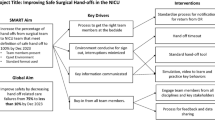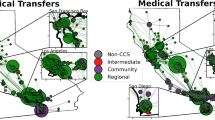Abstract
Objective
To compare the incidence, severity, preventability, and contributing factors of non-routine events—deviations from optimal care based on the clinical situation—associated with team-based, nurse-to-nurse, and mixed handovers in a large cohort of surgical neonates.
Study design
A prospective observational study and one-time cross-sectional provider survey were conducted at one urban academic children’s hospital. 130 non-cardiac surgical cases in 109 neonates who received pre- and post-operative NICU care.
Results
The incidence of clinician-reported NREs was high (101/130 cases, 78%) but did not differ significantly across acuity-tailored neonatal handover practices. National Surgical Quality Improvement—Pediatric occurrences of major morbidity were significantly higher (p < 0.001) in direct team handovers than indirect nursing or mixed handovers.
Conclusions
NREs occur at a high rate and are of variable severity in neonatal perioperative care. NRE rates and contributory factors were homogenous across handover types. Surveyed clinicians recommend structured handovers for all patients at every transfer point regardless of acuity.
This is a preview of subscription content, access via your institution
Access options
Subscribe to this journal
Receive 12 print issues and online access
$259.00 per year
only $21.58 per issue
Buy this article
- Purchase on SpringerLink
- Instant access to full article PDF
Prices may be subject to local taxes which are calculated during checkout

Similar content being viewed by others
References
Patterson ES, Wears RL. Patient handoffs: standardized and reliable measurement tools remain elusive. Jt Comm J Qual Patient Saf. 2010;36:52–61.
Catchpole KR, de Leval MR, McEwan A, Pigott N, McQuillan A, MacDonald C, et al. Patient handover from surgery to intensive care: using Formula 1 pit-stop and aviation models to improve safety and quality. Paediatr Anaesth. 2007;17:470–8.
Woods DMML. Patient transitions and handovers across the continuum of surgical care. In: Sanchez JBP, Johnson J, Jacobs J, editors. Surgical patient care. Switzerland: Springer International Publishing; 2017.
Segall N, Bonifacio AS, Schroeder RA, Barbeito A, Rogers D, Thornlow DK, et al. Can we make postoperative patient handovers safer? A systematic review of the literature. Anesth Analg. 2012;115:102–15.
Segall N, Bonifacio AS, Barbeito A, Schroeder RA, Perfect SR, Wright MC, et al. Operating room-to-ICU patient handovers: a multidisciplinary human-centered design approach. Jt Comm J Qual Patient Saf. 2016;42:400–14.
Spooner AJ, Aitken LM, Corley A, Fraser JF, Chaboyer W. Nursing team leader handover in the intensive care unit contains diverse and inconsistent content: an observational study. Int J Nurs Stud. 2016;61:165–72.
Spooner AJ, Chaboyer W, Corley A, Hammond N, Fraser JF. Understanding current intensive care unit nursing handover practices. Int J Nurs Pract. 2013;19:214–20.
Raju TN, Suresh G, Higgins RD. Patient safety in the context of neonatal intensive care: research and educational opportunities. Pediatr Res. 2011;70:109–15.
Kaushal R, Bates DW, Landrigan C, McKenna KJ, Clapp MD, Federico F, et al. Medication errors and adverse drug events in pediatric inpatients. JAMA. 2001;285:2114–20.
Bucher BT, Duggan EM, Grubb PH, France DJ, Lally KP, Blakely ML.Does the American College of Surgeons National Surgical Quality Improvement Program pediatric provide actionable quality improvement data for surgical neonates? J Pediatr Surg. 2016 Sep;51:1440–4. https://doi.org/10.1016/j.jpedsurg.2016.02.084 Epub 2016 Mar 10. PMID:27046303.
Saito JM, Chen LE, Hall BL, Kraemer K, Barnhart DC, Byrd C, et al. Risk-adjusted hospital outcomes for children’s surgery. Pediatrics. 2013;132:e677–688.
Bruny JL, Hall BL, Barnhart DC, Billmire DF, Dias MS, Dillon PW, et al. American College of Surgeons National Surgical Quality Improvement Program Pediatric: a beta phase report. J Pediatr Surg. 2013;48:74–80.
Oken A, Rasmussen MD, Slagle JM, Jain S, Kuykendall T, Ordonez N, et al. A facilitated survey instrument captures significantly more anesthesia events than does traditional voluntary event reporting. Anesthesiology. 2007;107:909–22.
Weinger MB, Slagle J. Human factors research in anesthesia patient safety. Proc AMIA Symp. 2001:756–60. PMID:11825287 PMCID: PMC2243459.
Weinger MB, Slagle J, Jain S, Ordonez N. Retrospective data collection and analytical techniques for patient safety studies. J Biomed Inform. 2003;36:106–19.
Weinger MB, Slagle JM, Kuntz AH, Schildcrout JS, Banerjee A, Mercaldo ND, et al. A multimodal intervention improves postanesthesia care unit handovers. Anesth Analg. 2015;121:957–71.
Raval M, Dillon P, Bruny J, Ko CY, Hall BL, Moss RL, et al. American College of Surgeons National Surgical Quality Improvement Program Pediatric: a phase 1 report. J Am Coll Surg. 2011;212:1–11.
Raval MV, Dillon PW, Bruny JL, Ko CY, Hall BL, Moss RL, et al. Pediatric American College of Surgeons National Surgical Quality Improvement Program: feasibility of a novel, prospective assessment of surgical outcomes. J Pediatr Surg. 2011;46:115–21.
Harris PA, Taylor R, Thielke R, Payne J, Gonzalez N, Conde JG. Research electronic data capture (REDCap)--a metadata-driven methodology and workflow process for providing translational research informatics support. J Biomed Inform. 2009;42:377–81.
Lorinc ARD, Slagle J, Tice J, France DJ, Weinger MB. Barriers to effective preoperative handover communication in the neonatal intensive care unit. In: Human factors and ergonomics society annual meeting. Vol. 58. Patricia R. DeLucia Sage Publishing. Chicago, IL; 2014. p. 1285-9.
Lorinc ACC, Sullivan M, Dickert J, Acton M, Baracz A. Pediatric preoperative handovers: does a checklist improve information exchange? American society of anesthesiology annual meeting. Lippincott Williams & Wilkins, Incorporated. Chicago, IL; 2016.
Choromanski D, Frederick J, McKelvey GM, Wang H. Intraoperative patient information handover between anesthesia providers. JBR. 2014;28:383–7.
Lane-Fall MB, Brooks AK, Wilkins SA, Davis JJ, Riesenberg LA. Addressing the mandate for hand-off education: a focused review and recommendations for anesthesia resident curriculum development and evaluation. Anesthesiology. 2014;120:218–29.
Barbeito A, Agarwala AV, Lorinc A. Handovers in perioperative care. Anesthesiol Clin. 2018;36:87–98.
Deming WE. Out of the crisis. Cambridge, MA: MIT Press; 1986.
Deming WE. The new economics. Cambridge, MA: MIT Press; 1993.
Acknowledgements
We greatly appreciate the informatics support Jonathan Wanderer, MD, and the Vanderbilt Anesthesiology & Perioperative Informatics Research (VAPIR) Division provided in developing an algorithm to automatically identify eligible study patients through the surgical schedule. Funding: This study was supported by funding from the National Institute of Child Health and Human Development (1R01HD086792-01).
Author contributions
All of the individuals listed as authors on the title page contributed to the conception, design, and execution of the study plan, contributed to the writing and/or revision of the manuscript, and approved the final version of the manuscript. Each author has had full access to the study data and was involved the final decision to submit these data for publication.
Author information
Authors and Affiliations
Corresponding author
Ethics declarations
Conflict of interest
The authors declare that they have no conflict of interest.
Additional information
Publisher’s note: Springer Nature remains neutral with regard to jurisdictional claims in published maps and institutional affiliations.
Rights and permissions
About this article
Cite this article
France, D.J., Slagle, J., Schremp, E. et al. Impact of patient handover structure on neonatal perioperative safety. J Perinatol 39, 453–467 (2019). https://doi.org/10.1038/s41372-018-0305-6
Received:
Revised:
Accepted:
Published:
Issue date:
DOI: https://doi.org/10.1038/s41372-018-0305-6



